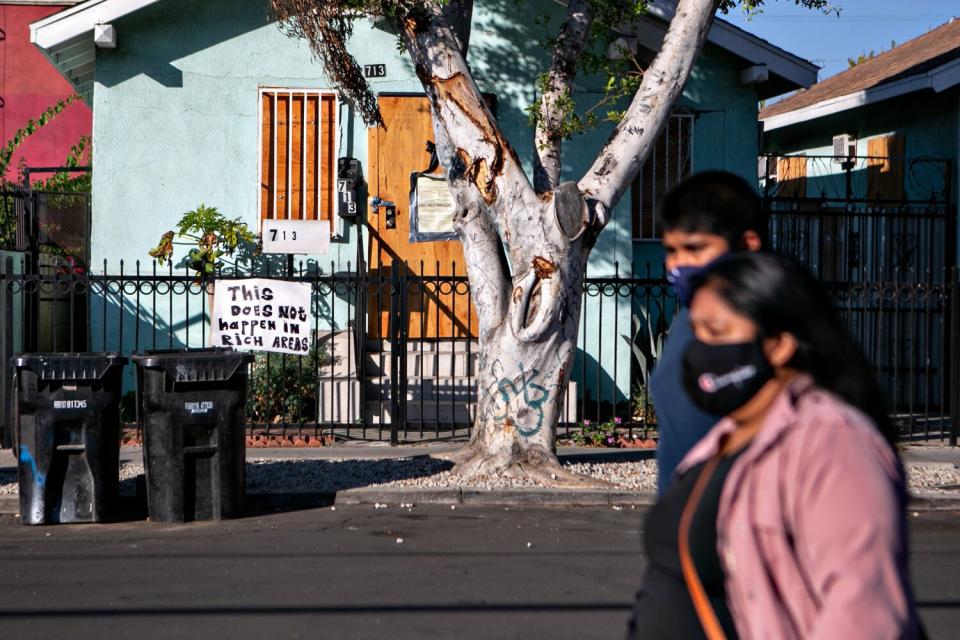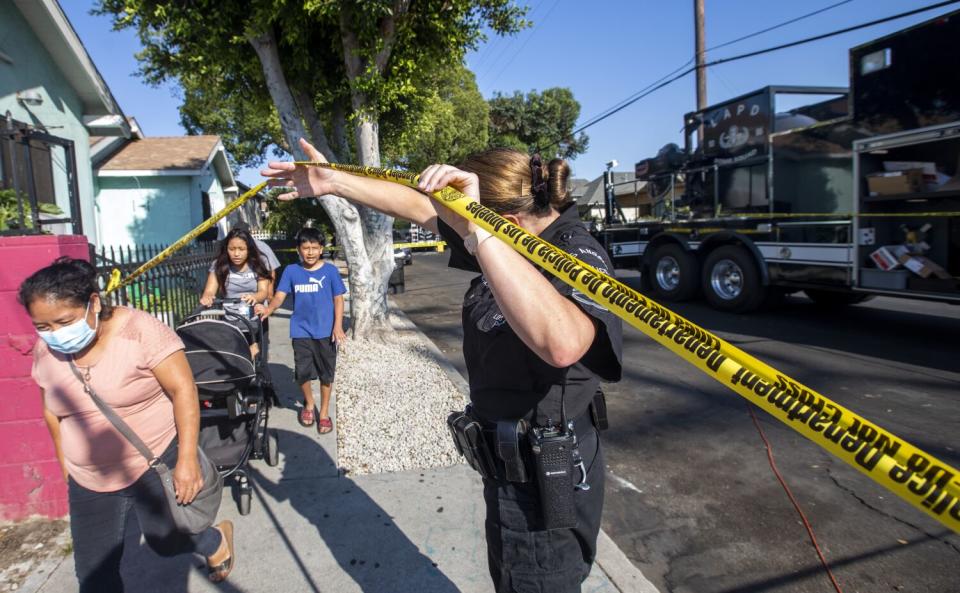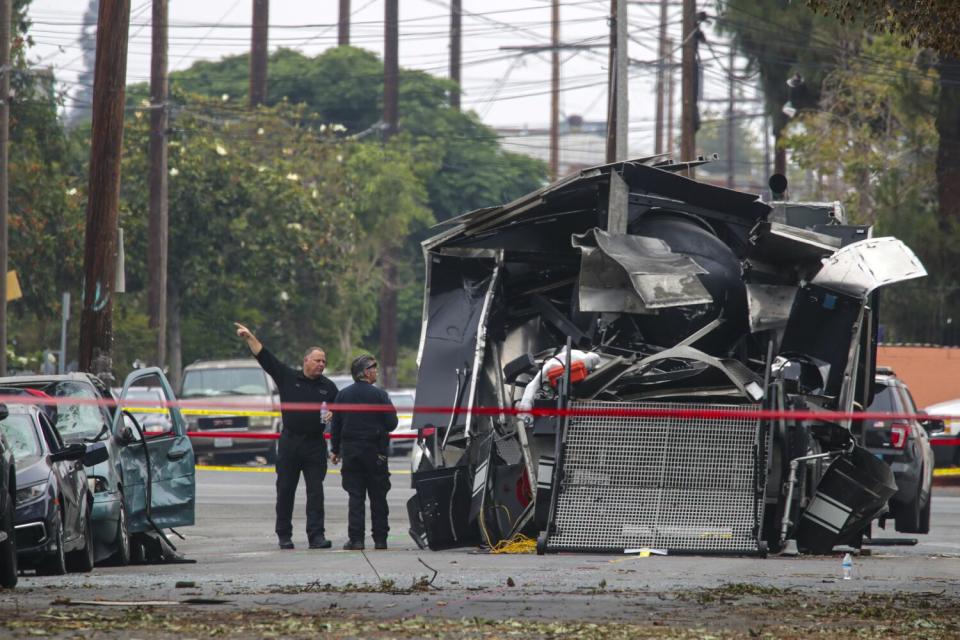LAPD refused to ID officers behind a huge fireworks explosion. Now we have their names

Before screaming "Fire in the hole!" and detonating a cache of confiscated fireworks on a residential street two years ago, Los Angeles police Det. Damien Levesque repeatedly walked away from critical discussions about the safety of the operation.
He was the supervisor on the scene, yet he brushed off a warning from a senior bomb technician that too many fireworks were being discharged at the same time, according to the Los Angeles Police Department inspector general's report which referred to Levesque only as "Supervising Detective A".
The resulting blast destroyed much of the surrounding South L.A. neighborhood and displaced dozens of people. Levesque was later moved out of the bomb squad — reassigned but not fired.
Despite repeated demands from residents who lost their homes to the blast, Levesque’s name and formal discipline in the matter had largely remained veiled, thanks to the LAPD’s secretive disciplinary system and its refusal to discuss personnel matters. Other members of the LAPD who were involved in the disaster have also remained anonymous, their discipline under seal.
In the inspector general’s report, the bomb squad personnel on scene were referred to only by letter designations. However, through investigative records, court documents and interviews, The Times was able to determine their names and how the LAPD dealt with some of the officers involved. The Times corroborated the identity of each bomb tech with at least two sources close to the department.
Mell Hogg, the lead technician — aka Bomb Tech A — had been on the bomb squad for less than three years. Following standard bomb-squad practice, Hogg did not weigh the powder from the fireworks the team intended to detonate in the LAPD's containment vessel and instead grossly underestimated its explosive power, according to the inspector general's report. He is now with the department’s training division, according to a recent roster.
Mark Richardson — Bomb Tech B — helped Hogg X-ray samples of the explosives, the inspector general's records show. Richardson still works in the emergency services division, which houses the bomb squad, but it is unclear in what role.
Brendan McCarty — Bomb Tech C — had 18 years of experience on the bomb squad and warned his fellow technicians and Levesque that the plan was not safe, the report said. McCarty has since retired from the force.
Thomas Deluccia — Bomb Tech D — arrived on scene that afternoon and helped load the commercial fireworks discovered at a home on East 27th Street onto pallets to transport away from the scene, the records state. Deluccia has also remained in the emergency services division, although it is unclear what his role is.
And, finally, there was 12-year bomb squad veteran Stefanie Alcocer, or Bomb Tech E. Alcocer was primarily responsible for constructing a countercharge, the report shows, the explosive used to detonate the fireworks inside the department’s “total containment vessel,” which failed in the blast. Alcocer was suspended for 10 days for her role in the incident, according to police officials. At some point after the blast, she was promoted to sergeant.
The Police Department on Wednesday declined to respond to a detailed list of questions, saying in a statement that state law bars it from discussing discipline against individual officers in most cases. State law allows the department to name officers who use force that results in great bodily injury; although the blast seriously injured 17 people, the LAPD still has not named the officers.
The inspector general's office declined through a spokeswoman to comment on the names.
Read more: News Analysis: Outrage over Times' journalism exposes LAPD's ignorance of a free press, experts say
Four officers tied to the incident have been disciplined, according to the LAPD. But police officials declined to say whether those The Times identified were among the group facing consequences for the explosion.
The only disciplinary action they’ve disclosed is Alcocer’s 10-day suspension, although they did not name her.
The total cost of the blast to the city remains unclear, but it is estimated that Los Angeles has spent more than $5 million to settle claims and house residents whose homes were badly damaged, according to city records. More than 100 claims have not been settled.

Transparency around officer discipline is important because it provides the public a necessary window into how and whether individual officers are held accountable for alleged misconduct, including in cases where that conduct harmed citizens. It also allows the public to raise questions about officers who have been accused of repeatedly violating department policy.
The latter category would include Richardson, who was among the officers allegedly involved in the Rampart scandal that broke in the late 1990s and shook the department.
According to a source familiar with the department’s investigation, at least some of the accused officers appeared before a disciplinary review panel, known as a board of rights. Officers appear before such panels when they are facing termination or if they request a panel review of lesser punishments such as suspension or demotion. The panels can — and often do — reduce punishments sought by police commanders.
The results of those panels are unclear.
Levesque and Deluccia declined to comment. McCarty did not respond to several requests for comment. Hogg and Richardson declined through the police union to respond to questions about the incident.
When two Times reporters knocked on Alcocer's door seeking comment, she denied she was the bomb squad tech and asked why the newspaper was pursuing the story. Officials later confirmed her identity.
She insisted that accounts of the incident had been misleading and suggested the decision to explode the fireworks was not rushed and that officers had spent many hours formulating a plan. She ultimately declined to comment for the story but said she was concerned for the safety of her family if her identity was revealed.


The inspector general’s report, issued last year, did little to help affected residents make sense of the explosion. Big questions remain about the destruction that uprooted their lives and devastated their neighborhood.
As recently as April, residents gathered outside LAPD headquarters to denounce Alcocer's 10-day suspension as being too light. Among them was Rosalba Beltran, who is still living in a hotel. She held a sign with three demands: "Fire the officers, release their names, criminal charges now."
"We want to know the names of all of the officers responsible for this explosion," Ron Gochez, a community organizer with Unión del Barrio who has helped organize residents, said at the protest. "If I do something bad in my job as a teacher, my name is going to be published, you'll see my face on the news. Why are the police treated differently? They don't protect our community, they protect themselves."
Read more: From a fireworks tip to ‘catastrophic failure’ in 12 hours: How the LAPD blew up a neighborhood
On the day of the blast, Levesque had been a bomb squad supervisor for less than three years.
He had previously served a five-year tour of duty as a bomb technician before transferring out of the unit, according to the inspector general's report. He briefly worked in Internal Affairs and then moved over to then-Police Chief Charlie Beck's office for several years, before returning to the squad in 2018, according to depositions in a retaliation lawsuit filed by Anthony Doyen, a former LAPD bomb squad officer.
Levesque's return to the squad was controversial. He had filled the position without having submitted an application or performance evaluations, according to a deposition by Mike Salinaz, then the officer in charge of the bomb squad. Others on the squad were also frustrated that a position was essentially created for Levesque, who returned with the pay of a Detective III rank on top of the hazard pay that comes with being on the bomb squad, according to the lawsuit.
Levesque did not have field supervisory experience before becoming a bomb squad supervisor, according to his own deposition in 2019.
Then on June 30, 2021, Levesque's leadership skills were put to the test.
Police had received a tip shortly before 8 a.m. that someone was selling illegal fireworks out of an alley in South L.A. Responding officers found dozens and dozens of boxes behind a pink house on East 27th Street.
Levesque dispatched Hogg and Richardson to the scene. Hogg had prior experience on the bomb K-9 unit, but he was still relatively new on the bomb squad. Richardson had been on the squad for close to nine years.

The substantial volume of fireworks prompted Hogg to call Levesque, who arrived soon after. They later discovered “improvised explosive devices” — homemade fireworks believed to contain flash powder.
Levesque initially focused on the removal of the commercial fireworks. But, as that neared completion, he gathered the five technicians who were on scene and instructed them to come up with a plan to deal with the homemade devices. He asked them to let him know what the plan was, but rather than listening to the discussion, he stepped away from the group, according to the inspector general's report.
"I try not to oversee and stand in on the discussion," Levesque later told investigators. If he were present, he said, his technicians might be scared to “ask a dumb question” or to say something that would indicate they were ill-informed about certain technical aspects of the work.
As the bomb technicians conferred over how to proceed, they agreed the explosives should be detonated on site rather than transporting them away, because many of the fireworks were leaking, according to the inspector general's report. Levesque agreed. That decision was made with Capt. Jeffrey Bratcher, the incident commander who was a higher-up at Newton Division, where the blast occurred, the report stated.
The inspector general's office later noted that it was common practice for the bomb squad to do detonations on scene. Levesque told investigators from the Bureau of Alcohol, Tobacco, Firearms and Explosives that the LAPD did not have a designated disposal range.
Hogg and Richardson X-rayed samples of the homemade fireworks and then cut them open to determine the amount of explosive material inside. According to the inspector general's report, the two technicians visually estimated the "net explosive weight" of the powder from the fireworks they intended to detonate in the containment vessel.
Hogg told ATF investigators that he estimated the explosive weight of the devices at 10 pounds. He said he had tried to be conservative, estimating higher weights than were likely, just to be safe.
Levesque later told investigators it was never the practice of the squad to physically weigh a suspected explosive before conducting a detonation.

Alcocer worked on creating a countercharge to detonate the fireworks inside the vessel, according to the inspector general's report. She based the design on the visual estimations made by Hogg and Richardson, according to the inspector general's report.
Of the bomb technicians on scene that day, Alcocer was the secondmost experienced. For years, Alcocer was the only female bomb tech who was with the unit full-time, according to a lawsuit she filed against the city alleging that she was sexually harassed by a male colleague whose advances she’d repeatedly rebuffed.
In a 2013 interview with Marie Claire, she spoke of beating out 39 officers for her spot on the bomb squad. She described it as "an elite post that requires an intensive year of training."
"We have a saying: 'In order to beat the bomber, you have to make the bomb.' I built a pipe bomb first; after that, I moved on to an improvised explosive device, or IED, by creating a circuit that led to the explosive, then attaching a timer," she said in the interview. "Blowing things up gives me an adrenaline bump and always has."
The day on 27th Street, the only person with more bomb tech experience than Alcocer was McCarty.
A seasoned tech, McCarty was tapped to teach courses on bomb disposal, once running a session on identifying and handling homemade explosives. As he helped Alcocer with the countercharge, he said he voiced concerns about the amount of material being loaded into the containment vessel, according to his and Levesque's interviews with investigators.
Levesque later told investigators he felt McCarty was not specific with his concerns.
He told McCarty and Alcocer to "hash it out" and again stepped away, according to his interview with ATF investigators.
“I don’t necessarily want to be involved in the planning process, I want to be involved in the outcome process,” he told investigators. "So I said, I'm gonna step away. You guys decide what you guys want to do."
McCarty told investigators he recalled telling Alcocer: "I have a bad feeling ... this is not good ... this is too big." Alcocer told him he needed to relax, he told the ATF, and that it would be OK.
Levesque told investigators that when he returned, no one brought any concerns to his attention that would have derailed or changed the plan. McCarty told investigators that he repeatedly warned that it was too much material and that the supervisor at one point told him to relax.
Deluccia appeared to play a minimal role in the detonation; Bomb Technician D is barely mentioned in the inspector general's report about the incident. But he later told ATF investigators that he shared in McCarty's concerns about the amount of explosives being detonated.
Bomb technicians at the scene believed that the maximum capability of the containment vessel was 40 pounds of net explosive weight, according to the inspector general's report. But the vessel actually was rated to handle only 33 pounds of explosives.
The ATF would later determine that the bomb squad had loaded the vessel with 39.8 pounds of explosives. That amount includes the countercharge.
Read more: LAPD badly miscalculated weight of fireworks before South L.A. explosion, ATF finds
Before the detonation, McCarty raised more concerns and called for the team to hold off until people could be moved farther back.
“We are not here for [the media to get] a good shot,” he recalled saying in a later interview with investigators. “This is about safety.”
This time, his colleagues listened. At about 7 p.m. officials expanded the perimeter on each side of the containment vessel and directed a media helicopter to move to a higher altitude.
But the resulting blast injured more than a dozen people — including eight LAPD officers, one ATF agent and at least six civilians — and damaged or destroyed 13 businesses, 22 residential properties and 37 vehicles, police have said. More than 80 people were displaced, and several are still living in a hotel.


The inspector general’s report later noted "a lack of active supervision" of bomb squad personnel that day. Levesque "took a hands-off approach to his duties in an attempt to make his subordinates feel more comfortable,” the report stated.
In his interviews with ATF, the report stated, Levesque recognized McCarty's expertise but, according to investigators, he "did not take action based on the concerns" that McCarty raised.
“It is the opinion of the OIG that [Levesque] failed to recognize numerous indicators that this incident required a higher level of supervision than that which was provided,” the report stated.
The inspector general's report detailed other missteps. The 46-page document pointed to a breakdown in decision-making, with no clear sense of who was in charge during the operation.
A review of the previous five years of training for the entire bomb squad revealed that its training hours had gradually declined. Meanwhile, Alcocer, one of the techs with the most experience, didn't meet the minimum training standards for any of the five years prior to the blast, according to the report.
Furthermore, in the past, the bomb squad included a sergeant who functioned as the officer in charge, but the position was vacant at the time.
Speaking to the Police Commission about the report, department officials acknowledged what Chief Michel Moore described as "systemic failures" that led to the botched detonation. Moore noted weaknesses in the level of supervision and pointed to what he said were wholesale changes to the unit's practices.
Another senior commander told the commission that the incident resulted in leadership changes.
But a review of personnel records shows that some in command that day have since moved up the ranks of the organization.
David Kowalski, a commander who oversaw the bomb unit at the time of the incident, was later elevated to deputy chief. Capt. Brian Morrison, another supervisor who was present that day, has remained in the emergency services division. Bratcher, the incident commander, has swiftly risen up the captain ranks.
Life for the residents of 27th Street has not been as good. About 50 people are living in a hotel. Houses remain boarded up. Justice seems far away.
From her hotel room this week, Beltran said she was pleased the officers responsible for the blast would be named by The Times.
"They were ignoring us, like nothing had happened, like we meant nothing," Beltran said. "They ignored us for two years, not even realizing all the damage they did to us."
Now it would be clear, she said, whom to hold responsible for blowing up their lives.
Sign up for Essential California, your daily guide to news, views and life in the Golden State.
This story originally appeared in Los Angeles Times.

